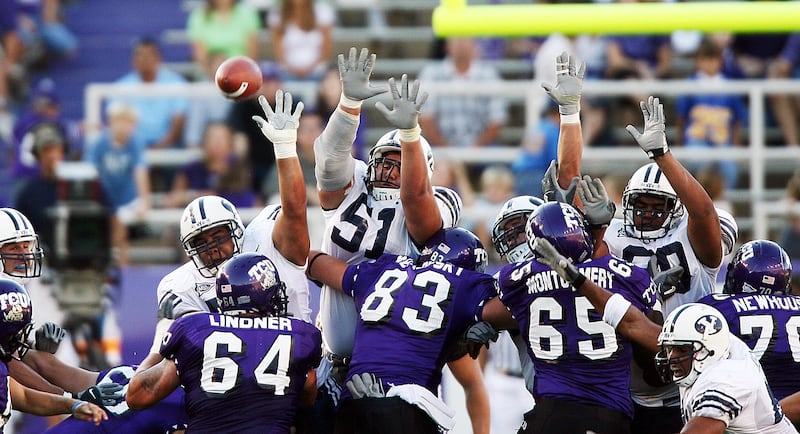Reality has set in for BYU’s football team. After a promising start to the season, after all the expectations and seven weeks in the top 25 and ranking as high as 12th, this is the state of the team: The defense has bigger gaps in it than Michael Strahan’s teeth; the Cougars have a record of 4-3; they not only dropped out of the top 25 but they didn’t receive a single vote this week; the crucial part of the schedule is behind them — Baylor, Oregon, Notre Dame, Arkansas.
That was make-or-break time. If they had won three or even two of those games they’d be in good shape. They won one of those games, beating Baylor (a way-overranked No. 9 at the time). The Notre Dame game — settled by eight points — is the one that got away.
In the pro version of the game, there is still hope after a 4-3 start, but college football is a different matter. Two losses pretty much doom any hope of making a national impact (unless it’s Alabama or Ohio State) and three losses means you’re done, especially if you’re a team from the West and an independent. BYU is both.
Head coach Kalani Sitake has the Cougars on solid ground, somewhere between mediocre and good, but certainly not great — about where they were during the last few years of the end of the Bronco Mendenhall era, minus the defense. They win the games they’re supposed to and lose the games they’re supposed to.
There is, of course, no conference title to play for (the curse of independence). Now the Cougars are playing to win an invitation to another forgettable bowl game and reach double digits in the win column for the third straight year. Even that looks like a stretch.
They start with a road game against 6-1 Liberty this week and two weeks later they go on the road again against a troublesome rival in Boise State. If Liberty is a step down for a BYU team that has played Notre Dame, Oregon and Arkansas in recent weeks, it’s the Super Bowl for Liberty, a rising relative newcomer to the FBS ranks.
Liberty coach Hugh Freeze told his team on Monday, “I want to be dead straight with you and I debated on exactly what to say about this. For those of you who are lucky enough —and I said lucky enough — to play in this game Saturday night, you’re getting ready to make history. It is, without a doubt, the biggest home football game this program has ever had.”
Liberty lost by a touchdown when it played BYU in Provo three years ago.
After enduring the past few games and looking ahead to next season’s Big 12 Conference launch, the Cougars are probably experiencing an epiphany like the one Sheriff Brody has in the famous “Jaws” scene when he gets his first glimpse of the shark and realizes what he’s up against: “We’re gonna need a bigger boat.”
The Cougars are preparing for their transition to the Big 12 next fall, but it’s clear they’ve got work to do if they want to compete for conference titles in the future. They only need to look 48 miles to the north to know what’s required, what’s possible and what growing pains to expect.
The Utes were coming off back-to-back 10-3 seasons when they joined the Pac-12 in 2011. They finished 8-5 the first year (their worst season in five years), followed by consecutive 5-7 seasons before finding their footing in the league. They raised their game. They have appeared in the Pac-12 championship game three of the last four years and claimed their first Pac-12 title last season.
The bigger boat will cost money. Utah’s athletic budget was $27.8 million for the fiscal year 2010 and by 2012 it was $35 million, a 26% increase. Their expenses were $78M in 2016, $81.6M in 2017, $87.5M in 2019 and $96M in 2019.
The Big 12, which will consist of 14 teams for the next two seasons until Texas and Oklahoma leave for the SEC in 2025, will not divide the league into divisions as was once discussed. Schools will play each other at least once in a two-year period. It should be a formidable league. Cincinnati, Kansas State, Oklahoma, Oklahoma State, Houston, TCU, Texas, West Virginia and BYU all have strong resumes.
The Cougars have collected four wins and three losses this season against opponents with a cumulative record of 23-23, and only two of those opponents were ranked at the time. Five current and future Big 12 teams appear in the current national rankings if you count Cincinnati, which will join BYU, Houston and UCF in a move to the league next fall.
TCU is ranked eighth, Oklahoma State 11th, Kansas State 17th, Texas 20th and Cincinnati 21st (future Big 12 team UCF and Kansas, are 29th and 30th in the “also receiving votes” category). Normally, powerhouse Oklahoma would be high in the rankings, but the Sooners are having a mediocre season after several of their top players transferred to follow their head coach to USC.
The Big 12 favors prolific offenses and generous defenses. Six Big 12 teams ranked in the top 30 for total offense and seven teams ranked in the top 27 for scoring. Only three Big 12 teams rank in the top 35 for total defense. BYU ranks 55th in total offense, 53rd in scoring, 94th in total defense and 99th in scoring defense.
That’s where things stand as the Cougars try to salvage something from their six remaining games (counting a bowl appearance) and prepare for their highly anticipated move to a Power Five conference.



